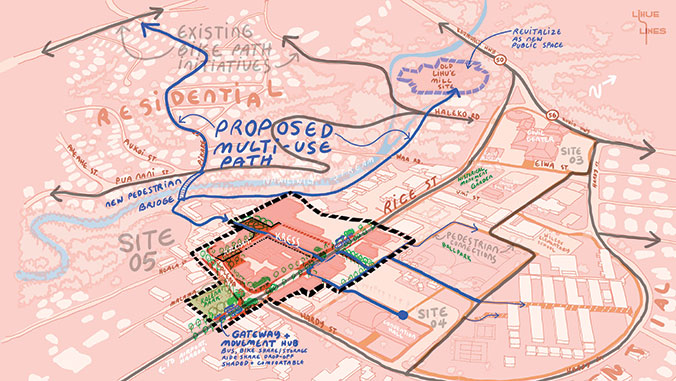
To help Kauaʻi and Honolulu counties respond to the challenges and opportunities that emerged from the COVID-19 pandemic, the University of Hawaiʻi Community Design Center (UHCDC) and UH Mānoa Institute for Sustainability and Resilience (ISR) hosted a week-long Mayors’ Institute Design Tank that gathered planning and design teams from three universities. “Design Tank” is a hybrid problem-solving process developed by UHCDC to integrate stakeholder and community engagement with proof-of-concept design inquiry, offering client institutions additional tools to define, prioritize, and plan capital development and improvements.
UH Mānoa design tank participants included Karla Sierralta, Simon Bussiere and Phoebe White, assistant professors in the School of Architecture, and Ashok Das, an associate professor in the Department of Urban and Regional Planning in the College of Social Sciences, supported UHCDC staff and students enrolled in architecture, landscape architecture and microbiology degree programs.
“This Design Tank was a unique opportunity to imagine temporary low-cost neighborhood-specific designs that can ignite future projects for more walkable communities in Hawaiʻi,” said Sierralta.
“It was a great opportunity to work with people from the islands and other design centers to give back to our Hawaiʻi community,” said Kristyn Yamamotoya, an architecture student.
This event is an example of UH Mānoa’s goal of Enhancing Student Success (PDF), one of four goals identified in the 2015–25 Strategic Plan (PDF), updated in December 2020.
Incorporating public outdoor spaces
The pandemic revealed ways in which public spaces can better support businesses and communities. New opportunities for sidewalk dining, open streets and a desire for open air environments have expanded the use of outdoor environments. Kauaʻi and Honolulu county partners used the Design Tank as an opportunity to envision new ways to integrate business operations, community programming and visual and performing arts into public outdoor spaces in more permanent ways.
“This welcome format leverages the potential of engaging researchers, designers and students with planning officials, policymakers and local stakeholders for improving the quality of the urban environment,” said Das. “The model is efficient in multiple ways, and effective for generating quality ideas that reflect progressive thinking in the design and planning fields.”
The Design Tank was a precursor to the Mayors’ Institute on City Design (MICD) regional session, which will bring eight mayors and eight topic area experts to Hawaiʻi to discuss common challenges among island and coastal communities. This will be the first time that Hawaiʻi has hosted a regional session in the program’s 35-year history.
“I know the future is bright with our UH Mānoa Architecture students at the helm! I was beyond impressed and inspired by the MICD Design Tank presentation, particularly given the short timeframe,” said Kauaʻi Mayor Derek S.K. Kawakami. “We are encouraged to think more creatively about how public space can be enhanced to bring meaning and connection to culture, history, and each other.”
The Design Tank was funded by the U.S. Conference of Mayors through the Mayors Institute on City Design Partnership.

